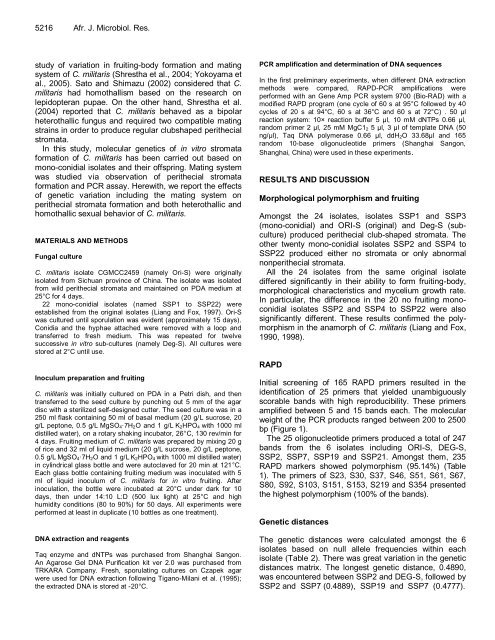Microbiology Research - Academic Journals
Microbiology Research - Academic Journals
Microbiology Research - Academic Journals
You also want an ePaper? Increase the reach of your titles
YUMPU automatically turns print PDFs into web optimized ePapers that Google loves.
5216 Afr. J. Microbiol. Res.<br />
study of variation in fruiting-body formation and mating<br />
system of C. militaris (Shrestha et al., 2004; Yokoyama et<br />
al., 2005). Sato and Shimazu (2002) considered that C.<br />
militaris had homothallism based on the research on<br />
lepidopteran pupae. On the other hand, Shrestha et al.<br />
(2004) reported that C. militaris behaved as a bipolar<br />
heterothallic fungus and required two compatible mating<br />
strains in order to produce regular clubshaped perithecial<br />
stromata.<br />
In this study, molecular genetics of in vitro stromata<br />
formation of C. militaris has been carried out based on<br />
mono-conidial isolates and their offspring. Mating system<br />
was studied via observation of perithecial stromata<br />
formation and PCR assay. Herewith, we report the effects<br />
of genetic variation including the mating system on<br />
perithecial stromata formation and both heterothallic and<br />
homothallic sexual behavior of C. militaris.<br />
MATERIALS AND METHODS<br />
Fungal culture<br />
C. militaris isolate CGMCC2459 (namely Ori-S) were originally<br />
isolated from Sichuan province of China. The isolate was isolated<br />
from wild perithecial stromata and maintained on PDA medium at<br />
25°C for 4 days.<br />
22 mono-conidial isolates (named SSP1 to SSP22) were<br />
established from the original isolates (Liang and Fox, 1997). Ori-S<br />
was cultured until sporulation was evident (approximately 15 days).<br />
Conidia and the hyphae attached were removed with a loop and<br />
transferred to fresh medium. This was repeated for twelve<br />
successive in vitro sub-cultures (namely Deg-S). All cultures were<br />
stored at 2°C until use.<br />
Inoculum preparation and fruiting<br />
C. militaris was initially cultured on PDA in a Petri dish, and then<br />
transferred to the seed culture by punching out 5 mm of the agar<br />
disc with a sterilized self-designed cutter. The seed culture was in a<br />
250 ml flask containing 50 ml of basal medium (20 g/L sucrose, 20<br />
g/L peptone, 0.5 g/L MgSO4·7H2O and 1 g/L K2HPO4 with 1000 ml<br />
distilled water), on a rotary shaking incubator, 26°C, 130 rev/min for<br />
4 days. Fruiting medium of C. militaris was prepared by mixing 20 g<br />
of rice and 32 ml of liquid medium (20 g/L sucrose, 20 g/L peptone,<br />
0.5 g/L MgSO4·7H2O and 1 g/L K2HPO4 with 1000 ml distilled water)<br />
in cylindrical glass bottle and were autoclaved for 20 min at 121°C.<br />
Each glass bottle containing fruiting medium was inoculated with 5<br />
ml of liquid inoculum of C. militaris for in vitro fruiting. After<br />
inoculation, the bottle were incubated at 20°C under dark for 10<br />
days, then under 14:10 L:D (500 lux light) at 25°C and high<br />
humidity conditions (80 to 90%) for 50 days. All experiments were<br />
performed at least in duplicate (10 bottles as one treatment).<br />
DNA extraction and reagents<br />
Taq enzyme and dNTPs was purchased from Shanghai Sangon.<br />
An Agarose Gel DNA Purification kit ver 2.0 was purchased from<br />
TRKARA Company. Fresh, sporulating cultures on Czapek agar<br />
were used for DNA extraction following Tigano-Milani et al. (1995);<br />
the extracted DNA is stored at -20°C.<br />
PCR amplification and determination of DNA sequences<br />
In the first preliminary experiments, when different DNA extraction<br />
methods were compared, RAPD-PCR amplifications were<br />
performed with an Gene Amp PCR system 9700 (Bio-RAD) with a<br />
modified RAPD program (one cycle of 60 s at 95°C followed by 40<br />
cycles of 20 s at 94°C, 60 s at 36°C and 60 s at 72°C) . 50 μl<br />
reaction system: 10× reaction buffer 5 μl, 10 mM dNTPs 0.66 μl,<br />
random primer 2 μl, 25 mM MgC12 5 μl, 3 μl of template DNA (50<br />
ng/μl), Taq DNA polymerase 0.66 μl, ddH2O 33.68μl and 165<br />
random 10-base oligonucleotide primers (Shanghai Sangon,<br />
Shanghai, China) were used in these experiments.<br />
RESULTS AND DISCUSSION<br />
Morphological polymorphism and fruiting<br />
Amongst the 24 isolates, isolates SSP1 and SSP3<br />
(mono-conidial) and ORI-S (original) and Deg-S (subculture)<br />
produced perithecial club-shaped stromata. The<br />
other twenty mono-conidial isolates SSP2 and SSP4 to<br />
SSP22 produced either no stromata or only abnormal<br />
nonperithecial stromata.<br />
All the 24 isolates from the same original isolate<br />
differed significantly in their ability to form fruiting-body,<br />
morphological characteristics and mycelium growth rate.<br />
In particular, the difference in the 20 no fruiting monoconidial<br />
isolates SSP2 and SSP4 to SSP22 were also<br />
significantly different. These results confirmed the polymorphism<br />
in the anamorph of C. militaris (Liang and Fox,<br />
1990, 1998).<br />
RAPD<br />
Initial screening of 165 RAPD primers resulted in the<br />
identification of 25 primers that yielded unambiguously<br />
scorable bands with high reproducibility. These primers<br />
amplified between 5 and 15 bands each. The molecular<br />
weight of the PCR products ranged between 200 to 2500<br />
bp (Figure 1).<br />
The 25 oligonucleotide primers produced a total of 247<br />
bands from the 6 isolates including ORI-S, DEG-S,<br />
SSP2, SSP7, SSP19 and SSP21. Amongst them, 235<br />
RAPD markers showed polymorphism (95.14%) (Table<br />
1). The primers of S23, S30, S37, S46, S51, S61, S67,<br />
S80, S92, S103, S151, S153, S219 and S354 presented<br />
the highest polymorphism (100% of the bands).<br />
Genetic distances<br />
The genetic distances were calculated amongst the 6<br />
isolates based on null allele frequencies within each<br />
isolate (Table 2). There was great variation in the genetic<br />
distances matrix. The longest genetic distance, 0.4890,<br />
was encountered between SSP2 and DEG-S, followed by<br />
SSP2 and SSP7 (0.4889), SSP19 and SSP7 (0.4777).

















